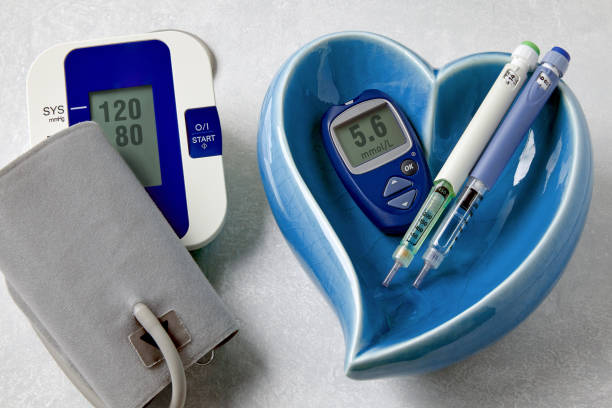GLP-1 receptor agonists are a type of medication used to manage type 2 diabetes. These drugs not only help lower blood sugar levels but also aid in weight loss.
Among the medications you can find under this class are Victoza (liraglutide), Byetta (exenatide), Ozempic (semaglutide) and Trulicity (dulaglutide). When combined with a balanced diet, regular exercise, and perhaps other diabetes medications, GLP-1 agonists can regulate hemoglobin A1C levels, improve cholesterol and blood pressure levels, as well as boost the function of beta cells found in the pancreas.

How GLP-1 Drugs Work on Various Organs in the Body
GLP-1 agonists affect several organs in the body all of which are necessary in the management of diabetes.
Brain
GLP-1 sends signals to the hypothalamus to reduce food and water intake. Since GLP-1 drugs can decrease thirst, it’s essential to stay well-hydrated by drinking plenty of water and other fluids while you are on these medications.
Muscle
GLP-1 stimulates a process called gluconeogenesis wherein the body makes glucose from protein or fat in order to lower blood sugar.
Pancreas
When GLP-1 interacts with glucose, it prompts the pancreas to release more insulin so that your blood sugar will be lower after meals. Also, the drug can decrease the release of glucagon, a hormone which can increase blood sugar levels in people with type 2 diabetes.
Liver
GLP-1 reduces the liver’s production of glucose and as gluconeogenesis increases, glucagon receptors in the liver also decrease.
Stomach
GLP-1 slows down the secretion of stomach acid and delays gastric emptying to prolong the feeling of fullness.
So essentially… GLP-1 drugs are able to:
- Boost insulin production
- Lower glucose production
- Suppress your appetite
…all of which are necessary if you have type 2 diabetes.
How to Take GLP-1 Agonist Medicines
You can take GLP-1 agonist medications either as injections or tablets. If you are prescribed injections, your healthcare provider will instruct you on the best sites for injection. These usually include:
- Your abdomen
- The front of your thighs
- Your upper arms
For tablets, you will take one each day upon waking on an empty stomach. Swallow the tablet with a small amount of water (no more than 120ml). It’s important to wait at least 30 minutes before eating, drinking, or taking any other medication.
Your healthcare provider will explain:
- The dosage (how much medicine to take)
- When to take the medicine
- How often to take the medicine
- You will receive a printed patient booklet to record these instructions for your medication regimen.
Your doctor may need to adjust your other diabetes medications and any changes will be clearly explained and documented in your patient booklet. Make sure to continue taking all your other medications as directed, unless your healthcare provider advises otherwise.
GLP-1 Treatment Goals and Monitoring for Patients with Diabetes
GLP-1 agonist medicines can improve blood sugar control in people with type 2 diabetes and aid in weight loss when combined with a healthy diet and lifestyle changes. These medications are prescribed for individuals who have not achieved adequate control of their diabetes with oral medications alone.
Before starting GLP-1 agonists, your healthcare provider will take some baseline measurements and repeat them after 3 and 6 months.
- Glycated hemoglobin (HbA1c)
- Weight
- Kidney function test
These measurements help assess whether the medication and lifestyle changes are improving your diabetes control and check for any potential side effects.
Your healthcare provider will record targets for your blood sugar control and weight loss after 6 months. Your progress towards these targets will be reviewed during follow-up visits.
Healthy Changes to Your Diet with GLP-1 Treatment
To manage type 2 diabetes, lose weight, and maintain overall health, dietary changes may be necessary.
You should:
- Eat small, regular meals throughout the day
- Eat vegetables and fruits daily
- Choose high-fiber, starchy foods
- Include vegetables or salad with each meal
- Spread fruit intake throughout the day due to its natural sugar content
- Reduce consumption of fried foods
- Consume lean meats like chicken or turkey
- Use artificial sweeteners if you must
- Replace sugary drinks with no added sugar varieties
- Limit fruit juice to no more than 125ml a day
- Avoid large portions of starchy carbs
- Cut down on saturated fats
- Avoid excessive sugary foods and drinks
- Reduce salt intake
- Limit alcohol consumption (14 units per week or less)

Type 2 Diabetes Medication Guidelines
The American College of Physicians (ACP) is stating in their latest clinical recommendations published in the Annals of Internal Medicine:
“ACP recommends adding a sodium-glucose cotransporter-2 (SGLT-2) inhibitor or glucagon-like peptide-1 (GLP-1) agonist to metformin and lifestyle interventions in patients with type 2 diabetes and inadequate glycemic control.”
The ACP guidelines also emphasize beneficial clinical outcomes over metrics like glycemic control. Treatment should be personalized for each patient.
“These updates align with current guidelines from the American Diabetes Association and the American College of Cardiology, reflecting contemporary clinical practice,” said Dr. Jacqueline Lonier, an assistant professor of medicine at Columbia University Irving Medical Center’s Naomi Berrie Diabetes Center.
“As most patients with type 2 diabetes are managed in primary care, the increasing use of SGLT2 inhibitors and GLP-1 agonists by primary-care physicians will improve outcomes for these patients on a broader scale.”
The guidelines advise against the use of dipeptidyl peptidase-4 (DPP-4) inhibitors for individuals with type 2 diabetes who have poor glycemic control. There is strong evidence indicating that these drugs do not lower the rates of morbidity or mortality.